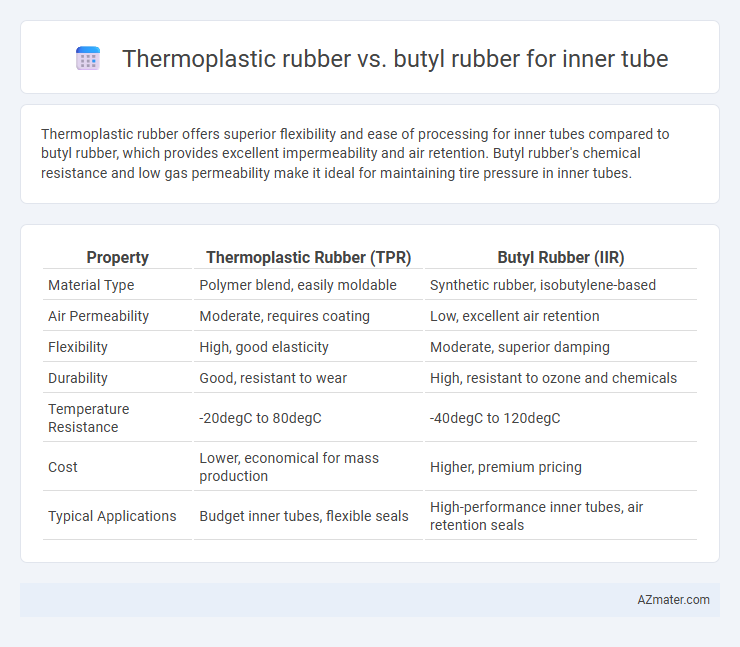Thermoplastic rubber offers superior flexibility and ease of processing for inner tubes compared to butyl rubber, which provides excellent impermeability and air retention. Butyl rubber's chemical resistance and low gas permeability make it ideal for maintaining tire pressure in inner tubes.
Table of Comparison
| Property | Thermoplastic Rubber (TPR) | Butyl Rubber (IIR) |
|---|---|---|
| Material Type | Polymer blend, easily moldable | Synthetic rubber, isobutylene-based |
| Air Permeability | Moderate, requires coating | Low, excellent air retention |
| Flexibility | High, good elasticity | Moderate, superior damping |
| Durability | Good, resistant to wear | High, resistant to ozone and chemicals |
| Temperature Resistance | -20degC to 80degC | -40degC to 120degC |
| Cost | Lower, economical for mass production | Higher, premium pricing |
| Typical Applications | Budget inner tubes, flexible seals | High-performance inner tubes, air retention seals |
Overview of Thermoplastic Rubber and Butyl Rubber
Thermoplastic rubber (TPR) is a versatile elastomer combining the elasticity of rubber with the processability of plastics, offering excellent flexibility and durability for inner tube applications. Butyl rubber, a synthetic rubber known for its superior airtightness, chemical resistance, and low gas permeability, remains the industry standard for inner tubes due to its ability to retain air over extended periods. The choice between TPR and butyl rubber hinges on factors such as long-term inflation retention, puncture resistance, and manufacturing methods, with butyl rubber preferred for high-performance inner tubes requiring airtight properties.
Material Composition and Structure
Thermoplastic rubber (TPR) used in inner tubes is composed of a blend of elastomers and thermoplastics, providing a flexible yet durable material with good elasticity and processability. Butyl rubber, a synthetic rubber composed primarily of isobutylene with a small amount of isoprene, offers superior air retention due to its low gas permeability and dense molecular structure. The unique polymer chains in butyl rubber create a tight, impermeable barrier, making it especially effective for inner tubes requiring long-lasting inflation and resistance to punctures.
Air Retention Capabilities
Thermoplastic rubber (TPR) offers moderate air retention for inner tubes due to its flexibility and resilience but tends to have higher permeability compared to butyl rubber. Butyl rubber excels in air retention capabilities in inner tubes because of its dense molecular structure, which significantly reduces gas permeability and maintains consistent pressure over time. Choosing butyl rubber for inner tubes ensures superior air retention, leading to longer intervals between inflation and enhanced tire performance.
Durability and Puncture Resistance
Thermoplastic rubber (TPR) offers excellent flexibility and chemical resistance but generally falls short in durability and puncture resistance compared to butyl rubber in inner tube applications. Butyl rubber is renowned for its superior air retention, exceptional puncture resistance, and long-lasting durability, making it the preferred material for high-performance and heavy-duty inner tubes. The enhanced impermeability and resilience of butyl rubber significantly reduce the likelihood of punctures and extend the inner tube's service life under harsh conditions.
Flexibility and Ride Comfort
Thermoplastic rubber offers superior flexibility and enhanced ride comfort for inner tubes due to its excellent elasticity and ability to absorb road vibrations effectively. Butyl rubber, known for its airtight properties and durability, is less flexible, which can result in a firmer ride and reduced shock absorption. Choosing thermoplastic rubber inner tubes improves suspension feel and reduces tire harshness, making it ideal for smoother, more comfortable cycling experiences.
Heat and Weather Resistance
Thermoplastic rubber (TPR) offers moderate heat resistance and good flexibility but tends to degrade faster under prolonged UV exposure compared to butyl rubber. Butyl rubber excels in heat resistance and superior weatherability, maintaining elasticity and impermeability even under extreme temperature fluctuations and harsh outdoor conditions. This makes butyl rubber the preferred choice for inner tubes requiring long-term durability against heat and weather.
Manufacturing and Cost Differences
Thermoplastic rubber (TPR) inner tubes offer streamlined manufacturing through injection molding, enabling faster production cycles and lower energy consumption compared to the traditional vulcanization process required for butyl rubber inner tubes. Butyl rubber demands more complex curing and mixing steps, leading to higher labor and equipment costs, which typically result in a more expensive final product. The cost efficiency and recyclability of TPR make it an attractive alternative for large-scale inner tube manufacturing, while butyl rubber remains preferred for applications needing superior air retention and chemical resistance despite its higher production costs.
Environmental Impact and Recyclability
Thermoplastic rubber (TPR) offers enhanced recyclability due to its ability to be repeatedly melted and reshaped, reducing waste accumulation compared to butyl rubber used in inner tubes. Butyl rubber, though valued for its excellent air retention and durability, presents environmental challenges due to its vulcanized structure, which complicates recycling and often leads to landfill disposal. Selecting TPR for inner tube manufacturing can significantly reduce environmental impact by facilitating circular material flows and minimizing persistent rubber waste.
Ideal Applications and Use Cases
Thermoplastic rubber (TPR) offers excellent flexibility, abrasion resistance, and temperature tolerance, making it ideal for automotive and bicycle inner tubes requiring frequent compression and rapid rebound. Butyl rubber excels in air impermeability and chemical resistance, making it the preferred choice for inner tubes used in high-pressure applications like heavy-duty trucks and off-road vehicles. Both materials provide durability, but TPR is favored for lightweight performance, while butyl rubber ensures longer air retention and stability in rugged environments.
Choosing the Best Inner Tube Material
Thermoplastic rubber (TPR) offers flexibility, lightweight properties, and resistance to abrasion, making it a strong candidate for inner tubes that demand durability and easy handling. Butyl rubber excels in air retention, puncture resistance, and chemical stability, which ensures longevity and reliability under varying pressure and temperature conditions. Choosing the best inner tube material depends on prioritizing air impermeability and puncture resistance, where butyl rubber typically outperforms TPR for long-term use and heavy-duty applications.

Infographic: Thermoplastic rubber vs Butyl rubber for Inner tube
 azmater.com
azmater.com